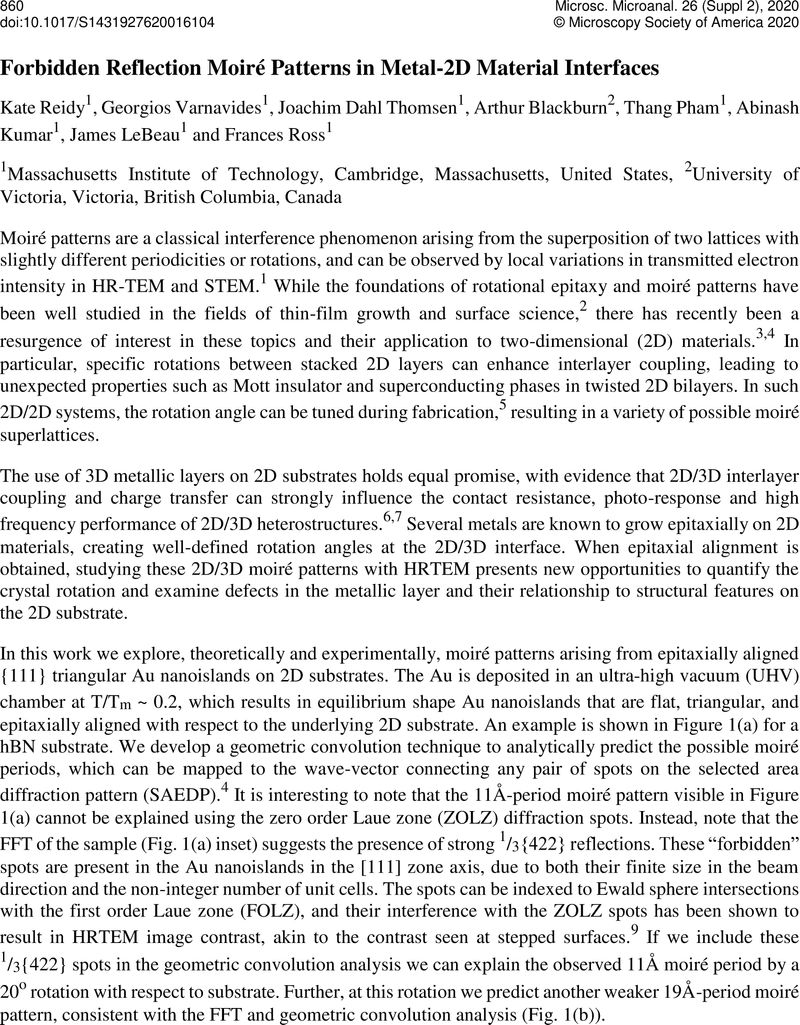No CrossRef data available.
Article contents
Forbidden Reflection Moiré Patterns in Metal-2D Material Interfaces
Published online by Cambridge University Press: 30 July 2020
Abstract
An abstract is not available for this content so a preview has been provided. As you have access to this content, a full PDF is available via the ‘Save PDF’ action button.

- Type
- New Frontiers in Electron Microscopy of Two-dimensional Materials
- Information
- Copyright
- Copyright © Microscopy Society of America 2020
References
Oster, G. & Nishijima, Y. Moiré Patterns. Scientific American 208, 54–63 (1963).10.1038/scientificamerican0563-54CrossRefGoogle Scholar
Bassett, G., Menter, J. & Pashley, D. Moiré patterns on electron micrographs, and their application to the study of dislocations in metals. Proc. R. Soc. London. Ser. A. Math. Phys. Sci. 246, 345–368 (1958).Google Scholar
Woods, C. R. et al. Commensurate-incommensurate transition in graphene on hexagonal boron nitride. Nat. Phys. 10, 451–456 (2014).10.1038/nphys2954CrossRefGoogle Scholar
Zeller, P. et al. What are the possible moiré patterns of graphene on hexagonally packed surfaces? Universal solution for hexagonal coincidence lattices, derived by a geometric construction. New J. Phys. 16, (2014).10.1088/1367-2630/16/8/083028CrossRefGoogle Scholar
Cao, Y. et al. Unconventional superconductivity in magic-angle graphene superlattices. Nature 556, 43–50 (2018).10.1038/nature26160CrossRefGoogle ScholarPubMed
Sundaram, R. S. et al. The graphene-gold interface and its implications for nanoelectronics. Nano Lett. 11, 3833–3837 (2011).10.1021/nl201907uCrossRefGoogle ScholarPubMed
Wang, Y. et al. Van der Waals contacts between three-dimensional metals and two-dimensional semiconductors. Nature 568, 70–74 (2019).10.1038/s41586-019-1052-3CrossRefGoogle Scholar
Buff, P.-A., Flueli, M., Spycher, R., Stadelmann, P. & Borelb, J.-P. Crystallographic Structure of Small Gold Particles studied by High-resolution Electron Microscopy. Faraday Discuss 92, (1991).Google Scholar
Reyes-Gasga, J., Gómez-Rodríguez, A., Gao, X. & José-Yacamán, M. On the interpretation of the forbidden spots observed in the electron diffraction patterns of flat Au triangular nanoparticles. Ultramicroscopy 108, 929–936 (2008).10.1016/j.ultramic.2008.03.005CrossRefGoogle ScholarPubMed



